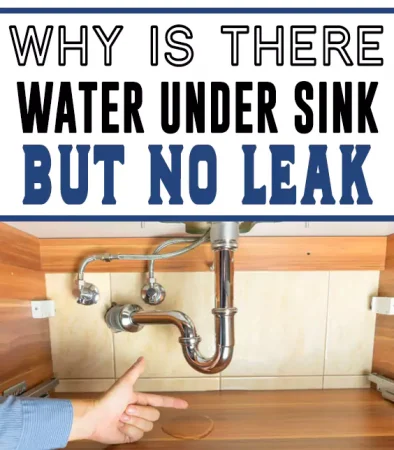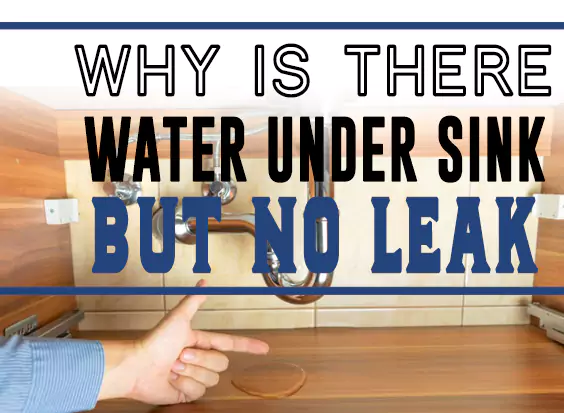Sometimes you may notice water puddles under your sink, yet you cannot spot the leak. There’s solutions if you have water under sink but no leak.
This means you have to figure out the source of the mystery water on your own. Because if not, the leak could end up causing significant water damage over time, which can be frustrating.
But where do you even start? There are several conceivable reasons for water under the sink even if there is no leak. It could be an issue with the supply line, P-trap, garbage disposal, dishwasher, or something else.

Possible Reasons for Unwanted Water Under Sink When You Can’t Find a Leak
Blocked P-trap
A P-trap is a plumbing fixture that traps debris in the sink drain to prevent clogs while also blocking sewer gasses. You can find it underneath the sink. However, since the trap is usually mounted out of view, it can be hard to notice a possible leak.
Essentially, a leak problem may occur when the p-trap has a blockage, resulting in moisture under kitchen sink.
Loose or overly tight water supply connection
Most sinks feature two water supply connections for hot and cold water. Over time, the compression nuts for these connections may become loose and start leaking.
However, even over-tightening the nuts during installation is a potential cause of mystery water under the sink. This is because the threads around the connection may crack, causing a leak. Unfortunately, it is not easy to catch sight of such a leak.
Worn out or broken seals
Plumbers will use different seals when installing sinks to ensure a watertight connection. Some use silicone adhesive around the edges of the sink or caulk, while others use rubber sealants.
Unfortunately, such seals are prone to damage over time. When this happens, you might notice condensation under the sink. But if the worn-out seal is around the drain system, it may be hard to detect the leak. This is unless the sink is full of water.
Damaged shut-off valve
Shut-off valves are hardly ever used. Because of this, the washer inside the valve can get damaged due to rust and other mineral deposits. In some cases, the compression nut for sealing the shut-off valve may also become loose. Gradually, you may start noticing water leaking under the bathroom sink cabinet.
Loose dishwasher valves
Over the years, the drain hoses, inlet valves, and other connections inside your dishwasher may loosen up. A damaged inlet valve may cause water to leak out of the dishwasher and end up under your kitchen sink.
This type of leak is usually a slow drip making it hard to spot. You should also watch out for loose metal clamps or cracked hoses.
Water filter issues
If your sink has a water filter, it might also be the reason you have unwanted water under the sink. This may happen when the filter housing is over-tightened, causing cracks on the threads. Also, faulty O-rings and hot water may damage the filters, thereby leaking water.
High water pressure
Unfortunately, most pipes and faucets may not withstand water pressure over 60 psi. Too much water pressure may lead to small leaks, structural damage, and even wet wood under the kitchen sink.
In most cases, the leaks may be occasional, making it difficult to determine where they are coming from. But eventually, the pipes may burst if you fail to address the water pressure issue.
Loose Garbage disposal seal
Garbage disposal is usually connected to your sink using plumbers’ putty or flange. However, with regular use, the seal may break or loosen up due to rust, thereby causing a leak.
In other instances, it could be that the mounting bolts securing the flange to the drain are not tight enough. In addition, the gasket between the seal and flange may become defective and start dripping water under the sink.
Corroded pipes
If your water’s pH is not balanced, your pipes will be more prone to corrosion and rust. Unfortunately, the rust in your plumbing system may eat away at your pipes and create an opening for water to seep through.
The mineral buildup may also clog your pipes, preventing normal water flow. Eventually, the drain pipes of your sink may start leaking and cause moisture under the bathroom sink.
Damaged sink sprayer hose
The sink sprayer is also prone to leaks due to a weak or loose connection. Unfortunately, the leaks are trickier to spot because they only occur when the water is running. Therefore, you will only find mysterious puddles under your kitchen sink.
How To Stop Water Leak Under the Sink
There are many ways to repair a water leak under the sink based on what is causing it. Here is how to do it.
Step 1: Shut down the water supply
Once you have located the leak, turn the shut-off valve counterclockwise to cut off the water supply.
Step 2: Replace leaky pipes and fittings
For a more permanent solution, you may want to replace the faulty pipes, gaskets, and washers with new ones. Just make sure to get the correct pipe sizes and fitting measurements.
Step 3: Apply a sealant
Unfasten your sink drain and remove any plumber’s putty around the gasket. Then, clean and dry the pipes. Next, apply a new layer of putty or silicone before screwing the drain back.
Step 4: Tighten the sink connections
Start by re-tightening the fittings around the sink drain and shut off valves using pliers but avoid over-tightening. Then, tighten the connection between the faucet and pipe.
Step 5: Unclog the p-trap
Next up, unscrew the P-trap from your drain pipe. Then, clean the trap using a bottle brush. If the O-rings and nuts are damaged, get a new set and reassemble the p-trap.
How Can You Tell Where a Water Leak Is Coming From
Can’t find leak under sink? Here are different ways to locate hidden leaks using simple household items.
To start with, you could use paper towels. You simply dry up water under a sink. Then, place the towels on the floor where you suspect the leak could be.
Next, observe for wet spots, which should be the exact leak location. Alternatively, you can wrap the leaky pipes with toilet paper.
Additionally, you can clean all the pipes and wipe them dry using a towel. Then, use a flashlight to scan for the leaks. Another way to tell where the leak is leaking from is to look out for wet walls or floors.
Lastly, you can put a few drops of food coloring in your toilet tank. If you notice the color in your toilet bowl, it means there is a leak in the toilet.
How to Troubleshoot if Water is Leaking Slowly Behind The Wall
First, you might spot a pool of water near the walls. In most cases, the water will collect around your washing machine or dishwasher. The water leak behind the wall may also lead to wallpaper or paint peeling.
Additionally, you should look out for stains or discoloration on the walls and ceilings. You see, if the wall has absorbed too much moisture, even the connected roof could be affected.
Another sign to watch out for is mold on non-shower areas, which may look like black spots. Because mold tends to thrive in moist environments. However, in some situations, you may not see the mold, but you could smell it.
In addition, a potent musty odor near your wall may be a hint of a leak behind it. This usually happens as a result of mold growth on the walls.
How to Troubleshoot If Pipes Are Leaking Under the Floor
The first things you will see are puddles of water on the floor or a damp carpet. If your flooring is carpeted, the areas where the leak is located may appear darker. On the other hand, wooden floors may show signs of warping because of a leak.
If your pipes are leaking under the floor, you may smell a musty odor due to mold growth. You might also notice mildew patches on your flooring. This happens when the leaking water stays on the floor for a long time.
When there is a leak in your sewer pipes, you may spot cracks in your tiled or brick floors. Your flooring could also warp. Sometimes, the leak may come from a broken hot water pipe. In such a case, the areas of your floor where the leak is may feel abnormally hot.
Can Water Come Up Through Tile?
Absolutely, but not very common. This happens if your house is built in an area with a high water table. And to make things worse, there are no measures established to drain the high-water table away from your house.
Another possible cause would be a leaky pipe, causing the water to come up through your tile grout joints. This happens especially when the grout lines in between your tiles wear out over time. The good news? With proper tile care, you may not have to worry about water coming up through the tiles.
How to Get Rid Of Damp Under the Sink
To begin with, you must establish what is causing the dampness under your sink. Once you find the source of the problem, which will most likely be a leak, fix it at once. It could be a leak on the drain pipe, faucet, P-trap, or even the garbage disposal line.
After fixing the leak, clean the area under your sink using a disinfectant or detergent. You can also use white vinegar, baking soda solution, or hydrogen peroxide. This will help kill any growing mold caused by the dampness.
For the best results, leave your cabinet doors open to allow the previously damp area to dry completely. Then, put a moisture absorber under your sink, such as rock salt, to soak up any remaining dampness. You could also use a dehumidifier in your home to keep moisture levels between 30% and 50%.
Key Takeaway
If there is water under a sink but no leak is found, it can be frustrating. As illustrated, there are many possible causes of this problem.
This, therefore, makes it easy to establish where the unwanted water would be coming from and fix the leak. For instance, the unwanted water may be due to a clogged P-trap, worn-out seals, or a damaged water supply connection.
The good thing is that you can stop a water leak under your sink using a sealant like plumbers putty. Also, re-tightening the sink connections or unclogging the trap may help halt the leak.

